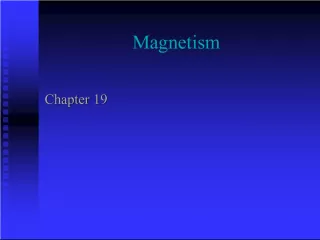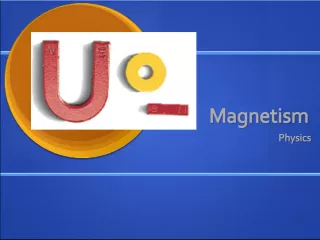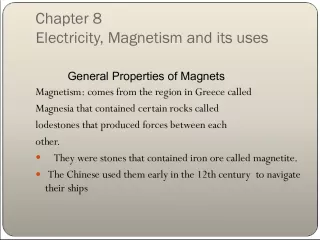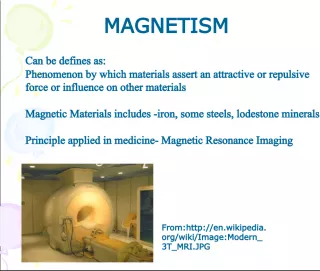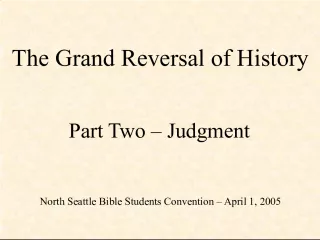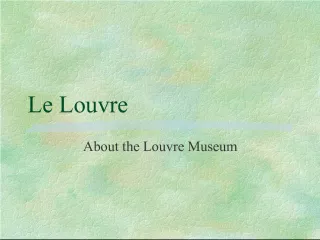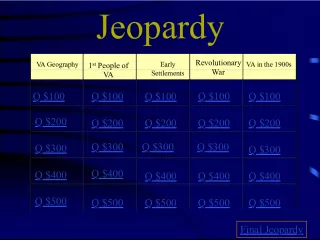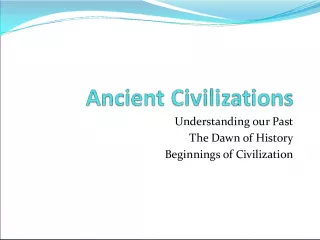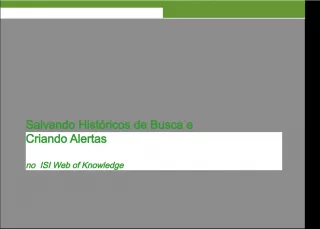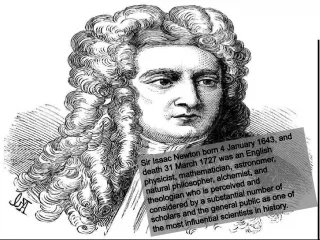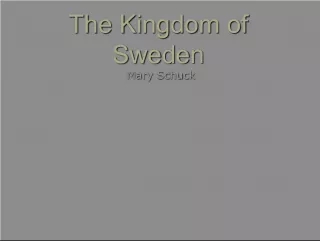A Brief History of Magnetism: From Compasses to Poles
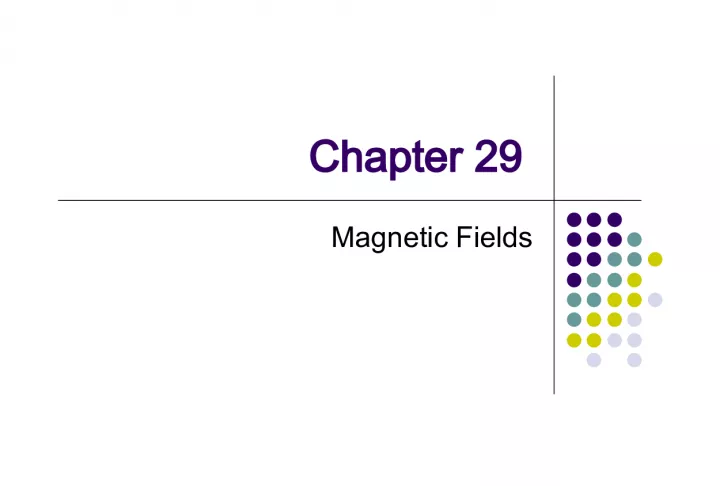

This article traces the origins of magnetism, from the discovery of magnetite by the Greeks to the invention of the compass by the Chinese. It also highlights the groundbreaking work of Pierre de Maricourt in identifying magnetic poles.
- Uploaded on | 2 Views
-
 leticia
leticia
About A Brief History of Magnetism: From Compasses to Poles
PowerPoint presentation about 'A Brief History of Magnetism: From Compasses to Poles'. This presentation describes the topic on This article traces the origins of magnetism, from the discovery of magnetite by the Greeks to the invention of the compass by the Chinese. It also highlights the groundbreaking work of Pierre de Maricourt in identifying magnetic poles.. The key topics included in this slideshow are magnetism, compass, magnetite, Pierre de Maricourt, poles,. Download this presentation absolutely free.
Presentation Transcript
1. Chapter 29 Magnetic Fields
2. A Brief History of Magnetism 13 th century BC Chinese used a compass Uses a magnetic needle Probably an invention of Arabic or Indian origin 800 BC Greeks Discovered magnetite (Fe 3 O 4 ) attracts pieces of iron
3. A Brief History of Magnetism, 2 1269 Pierre de Maricourt found that the direction of a needle near a spherical natural magnet formed lines that encircled the sphere The lines also passed through two points diametrically opposed to each other He called the points poles
4. A Brief History of Magnetism, 3 1600 William Gilbert Expanded experiments with magnetism to a variety of materials Suggested the Earth itself was a large permanent magnet
5. A Brief History of Magnetism, 4 1819 Hans Christian Oersted Discovered the relationship between electricity and magnetism An electric current in a wire deflected a nearby compass needle
6. A Brief History of Magnetism, final 1820s Faraday and Henry Further connections between electricity and magnetism A changing magnetic field creates an electric field Maxwell A changing electric field produces a magnetic field
7. Magnetic Poles Every magnet, regardless of its shape, has two poles Called north and south poles Poles exert forces on one another Similar to the way electric charges exert forces on each other Like poles repel each other N-N or S-S Unlike poles attract each other N-S
8. Magnetic Poles, cont. The poles received their names due to the way a magnet behaves in the Earths magnetic field If a bar magnet is suspended so that it can move freely, it will rotate The magnetic north pole points toward the Earths north geographic pole This means the Earths north geographic pole is a magnetic south pole Similarly, the Earths south geographic pole is a magnetic north pole
9. Magnetic Poles, final The force between two poles varies as the inverse square of the distance between them A single magnetic pole has never been isolated In other words, magnetic poles are always found in pairs All attempts so far to detect an isolated magnetic pole has been unsuccessful No matter how many times a permanent magnetic is cut in two, each piece always has a north and south pole
10. 29.1 Magnetic Fields Reminder: an electric field surrounds any electric charge The region of space surrounding any moving electric charge also contains a magnetic field A magnetic field also surrounds a magnetic substance making up a permanent magnet
11. Magnetic Fields, cont. A vector quantity Symbolized by Direction is given by the direction a north pole of a compass needle points in that location Magnetic field lines can be used to show how the field lines, as traced out by a compass, would look
12. Magnetic Field Lines, Bar Magnet Example The compass can be used to trace the field lines The lines outside the magnet point from the North pole to the South pole Use the active figure to trace the field lines PLAY ACTIVE FIGURE
13. Magnetic Field Lines, Bar Magnet Iron filings are used to show the pattern of the electric field lines The direction of the field is the direction a north pole would point
14. Magnetic Field Lines, Unlike Poles Iron filings are used to show the pattern of the electric field lines The direction of the field is the direction a north pole would point Compare to the electric field produced by an electric dipole
15. Magnetic Field Lines, Like Poles Iron filings are used to show the pattern of the electric field lines The direction of the field is the direction a north pole would point Compare to the electric field produced by like charges
16. Definition of Magnetic Field The magnetic field at some point in space can be defined in terms of the magnetic force, The magnetic force will be exerted on a charged particle moving with a velocity, Assume (for now) there are no gravitational or electric fields present
17. Force on a Charge Moving in a Magnetic Field The magnitude F B of the magnetic force exerted on the particle is proportional to the charge, q , and to the speed, v , of the particle When a charged particle moves parallel to the magnetic field vector, the magnetic force acting on the particle is zero When the particles velocity vector makes any angle 0 with the field, the force acts in a direction perpendicular to both the velocity and the field
18. F B on a Charge Moving in a Magnetic Field, final The magnetic force exerted on a positive charge is in the direction opposite the direction of the magnetic force exerted on a negative charge moving in the same direction The magnitude of the magnetic force is proportional to sin , where is the angle the particles velocity makes with the direction of the magnetic field
19. More About Direction is perpendicular to the plane formed by and Oppositely directed forces exerted on oppositely charged particles will cause the particles to move in opposite directions
20. Force on a Charge Moving in a Magnetic Field, Formula The properties can be summarized in a vector equation: is the magnetic force q is the charge is the velocity of the moving charge is the magnetic field
21. Direction: Right-Hand Rule #1 The fingers point in the direction of comes out of your palm Curl your fingers in the direction of The thumb points in the direction of which is the direction of
22. Direction: Right-Hand Rule #2 Alternative to Rule #1 Thumb is in the direction of Fingers are in the direction of Palm is in the direction of On a positive particle You can think of this as your hand pushing the particle
23. More About Magnitude of F The magnitude of the magnetic force on a charged particle is F B = |q| v B sin is the smaller angle between v and B F B is zero when the field and velocity are parallel or antiparallel = 0 or 180 o F B is a maximum when the field and velocity are perpendicular = 90 o
24. Differences Between Electric and Magnetic Fields Direction of force The electric force acts along the direction of the electric field The magnetic force acts perpendicular to the magnetic field Motion The electric force acts on a charged particle regardless of whether the particle is moving The magnetic force acts on a charged particle only when the particle is in motion
25. More Differences Between Electric and Magnetic Fields Work The electric force does work in displacing a charged particle The magnetic force associated with a steady magnetic field does no work when a particle is displaced This is because the force is perpendicular to the displacement
26. Work in Fields, cont. The kinetic energy of a charged particle moving through a magnetic field cannot be altered by the magnetic field alone When a charged particle moves with a given velocity through a magnetic field, the field can alter the direction of the velocity, but not the speed or the kinetic energy
27. Units of Magnetic Field The SI unit of magnetic field is the tesla (T) Wb is a weber A non-SI commonly used unit is a gauss (G) 1 T = 10 4 G
28. 29.2 Magnetic Force on a Current Carrying Conductor A force is exerted on a current-carrying wire placed in a magnetic field The current is a collection of many charged particles in motion The direction of the force is given by the right-hand rule
29. Force on a Wire In this case, there is no current, so there is no force Therefore, the wire remains vertical
30. Force on a Wire (2) The magnetic field is into the page The current is up the page The force is to the left
31. Force on a Wire, (3) The magnetic field is into the page The current is down the page The force is to the right
32. Force on a Wire, equation The magnetic force is exerted on each moving charge in the wire The total force is the product of the force on one charge and the number of charges
33. Force on a Wire, (4) In terms of the current, this becomes I is the current is a vector that points in the direction of the current Its magnitude is the length L of the segment is the magnetic field
34. Force on a Wire, Arbitrary Shape Consider a small segment of the wire, The force exerted on this segment is The total force is
35. 29.3 Torque on a Current Loop in a Uniform Magnetic Field The rectangular loop carries a current I in a uniform magnetic field No magnetic force acts on sides 1 & 3 The wires are parallel to the field and
36. Torque on a Current Loop, 2 There is a force on sides 2 & 4 since they are perpendicular to the field The magnitude of the magnetic force on these sides will be: F 2 = F 4 = I a B The direction of F 2 is out of the page The direction of F 4 is into the page
37. Torque on a Current Loop, 3 The forces are equal and in opposite directions, but not along the same line of action The forces produce a torque around point O
38. Torque on a Current Loop, Equation The maximum torque is found by: The area enclosed by the loop is ab , so max = I AB This maximum value occurs only when the field is parallel to the plane of the loop
39. Torque on a Current Loop, General Assume the magnetic field makes an angle of < 90 o with a line perpendicular to the plane of the loop The net torque about point O will be = I AB sin Use the active figure to vary the initial settings and observe the resulting motion PLAY ACTIVE FIGURE
40. Torque on a Current Loop, Summary The torque has a maximum value when the field is perpendicular to the normal to the plane of the loop The torque is zero when the field is parallel to the normal to the plane of the loop where is perpendicular to the plane of the loop and has a magnitude equal to the area of the loop
41. Direction The right-hand rule can be used to determine the direction of Curl your fingers in the direction of the current in the loop Your thumb points in the direction of
42. Magnetic Dipole Moment The product I is defined as the magnetic dipole moment , , of the loop Often called the magnetic moment SI units: A m 2 Torque in terms of magnetic moment: Analogous to for electric dipole
43. Potential Energy The potential energy of the system of a magnetic dipole in a magnetic field depends on the orientation of the dipole in the magnetic field: U min = B and occurs when the dipole moment is in the same direction as the field U max = + B and occurs when the dipole moment is in the direction opposite the field
44. 29.4 Motion of a Charged Particle in a Uniform Magnetic Field REMARKS When vectors are perpendicular to the page, dots and crosses are used The dots represent the arrows coming out of the page The crosses represent the arrows going into the page
45. Charged Particle in a Magnetic Field Consider a particle moving in an external magnetic field with its velocity perpendicular to the field The force is always directed toward the center of the circular path The magnetic force causes a centripetal acceleration, changing the direction of the velocity of the particle Use the active figure to change the parameters of the particle and observe the motion PLAY ACTIVE FIGURE
46. Force on a Charged Particle Equating the magnetic and centripetal forces: Solving for r: r is proportional to the linear momentum of the particle and inversely proportional to the magnetic field
47. More About Motion of Charged Particle The angular speed of the particle is The angular speed, , is also referred to as the cyclotron frequency The period of the motion is
48. Motion of a Particle, General If a charged particle moves in a magnetic field at some arbitrary angle with respect to the field, its path is a helix Same equations apply, with Use the active figure to vary the initial velocity and observe the resulting motion PLAY ACTIVE FIGURE
49. Bending of an Electron Beam Electrons are accelerated from rest through a potential difference The electrons travel in a curved path Conservation of energy will give v Other parameters can be found
50. Particle in a Nonuniform Magnetic Field The motion is complex For example, the particles can oscillate back and forth between two positions This configuration is known as a magnetic bottle
51. Van Allen Radiation Belts The Van Allen radiation belts consist of charged particles surrounding the Earth in doughnut-shaped regions The particles are trapped by the Earths magnetic field The particles spiral from pole to pole May result in Auroras
